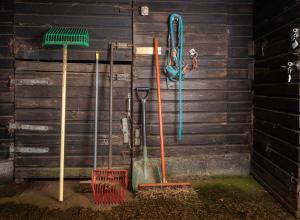Guide To Trailer Hitches

If you’re thinking of towing a load, whether a horse trailer, RV, boat, or something else, you need to familiarize yourself with trailer hitches before your load becomes unhitched and you become unhinged. Here’s our guide to trailer hitches to keep you moving and sane, with your load safely attached.
Before you start: do you have the right vehicle to tow safely?
Before you even try to hitch something up, you should determine what the overall weight and tongue weight is on the trailer you will be hauling. You can start by checking the manufacturer’s decal sticker if they added the information there, or you can take the trailer to a commercial scale and have it weighed.
Next, determine the towing capacity and tongue weight capacity on your towing vehicle’s hitch. Once you have both the trailer weights and towing vehicle’s weight capacities, you can determine if it’s safe to tow your trailer. As long as the weight and tongue weight of the trailer do not exceed the capacity of the tow vehicle, then you should be safe to tow. If it does, then you’ll either need to downsize your trailer or upgrade your vehicle.
Tow vehicle hitches and components
A trailer hitch is any device that attaches to a tow vehicle and provides the connection between the vehicle doing the towing and what’s being towed. Most hitch installations are permanent, and they can be used to tow anything on wheels you can dream up. Hitches come in a couple of types and configurations. Fixed drawbar and receiver hitches are the two types of bumper hitches, while gooseneck (or fifth-wheel couplings) are permanently installed in the truck bed.
Fixed-drawbar hitch

Fixed-drawbar hitches describe a single mounted hitch piece with a hole for the trailer’s ball. These are normally built with an integrated ball platform for the trailer mount, and they are not usually compatible with aftermarket hitch-mounted accessories. “Drawbar” is used to distinguish a non-adjustable ball mount or coupling configuration vs. a hitch ball.
This type of hitch is ideal for towing long, wide trailers.
Gooseneck hitch
Gooseneck (or fifth-wheel) hitches are often used to tow livestock trailers or RVs. This heavy–duty hitch system is permanently installed into the bed of a pickup truck that’s equipped to tow this way. The fifth-wheel coupling allows the truck to carry some of the weight directly, instead of just pulling it along via the bumper. This changes the center of gravity, which reduces sway. If you hear someone refer to their RV as a ‘fifth wheel,’ they are referring to the type of large RV that has to be pulled using this system.
Most trucks do not come standard with a gooseneck hitch installed, so the extra cost is something to consider when you’re evaluating what to haul and how.
Receiver hitch

A receiver is another type of bumper hitch that is a receptacle or tube that is bolted, welded, or otherwise integrated with the vehicle’s chassis, and they come in many sizes, depending on how they are used. If you’re using a ball mount in a receiver hitch, you can expect it to be a square ball that fits into the receiver that’s attached to the vehicle (...and the green grass grew all around, all around, and the green grass grew all around).
Receiver hitches can hold many different types of tow hitches when the tow hook or ball is attached via the receiver tube that’s attached to the tow vehicle. Removable receiver hitch ball mounts also vary in rise or drop to level out height differences between your tow vehicle and trailer, and these are great for small trailers, cargo carriers, and bike racks.
Weight-distributing hitch

Hitches that level or redistribute the hauled load are called “weight-distributing hitches.” They are almost always intended for use with a mounted receiver hitch. This setup uses tension from a spring bar and chain mounted to the tow vehicle to redistribute part of the trailer’s hitch weight away from the towing vehicle’s rear axle and toward the tow vehicle’s front axle and the trailer’s axle(s). This minimizes swaying and hopping to avoid jerking the tow vehicle, fishtailing, or worse.
Most manufacturers strongly recommend a maximum trailer capacity of 5,000 lbs (2300 kg) and 500 pounds (230 kg) of tongue weight without a weight-distributing hitch.
at Transwest of Frederick, CO
Used Livestock Trailer
Front Tack
at Transwest of Frederick, CO
New Horse Trailer
3 Horses
Bumper
Slant
Front Tack
at Transwest of Frederick, CO
New Horse Trailer
8 Horses
Gooseneck
Slant
Front Tack
Sold
at Transwest of Frederick, CO
Used Horse Trailer
3 Horses
Bumper
Slant
Front Tack
Horse & Livestock Trailers For Sale

2021 Hart Stock/Combo


2025 Cimarron Norstar 3HBP





2024 Cimarron Norstar 8HGN





2001 CM 3HBP




Ball sizes, load capacity, and more
Ball sizes
Depending on the load you carry, trailer hitch balls come in a lot of different sizes. The trailer tongue or coupling slips over the trailer hitch ball that may be attached to the receiver mount (receiver hitch) or integrated into the hitch (fixed drawbar hitch).
| Typical Hitch Ball Sizes - North America | ||
| Ball Size | Shank Diameter | Average Maximum Capacity |
| 1 ⅞ inches (47.6 mm) | ¾ in (19.1 mm) | 2000 lb (910 kg) |
| 1 in (25.4 mm) | 2000 lb (910 kg) | |
| 2 inches (50.8 mm) | ¾ in (19.1 mm) | 3500 lb (1600 kg) |
| 1 in (25.4 mm) | 6000 lb (2720 kg) | |
| 1 ¼ in (31.8 mm) | 6000 lb (2720 kg) | |
| 1 ⅜ in (34.9 mm) | 10000 lb (4500 kg) | |
| 2 5/16 in (58.7 mm) | 1 in (25.4 mm) | 6000 lb (2720 kg) |
| 1 ¼ in (31.8 mm) | 10000 lb (4500 kg) | |
| 3 in (76.2 mm) | 2 in (50.8 mm) | >10000 lb (4500 kg) |
Load classes
According to the Society of Automotive Engineers, there are 4 classes of trailer hitches:
- Class I: up to 2000 lbs (910 kg) trailer weight and 200 lbs tongue weight.
- Class II: up to 3500 lbs (1600 kg) trailer weight and 350 lbs tongue weight.
- You can haul some lightweight trailers, kayak or bike haulers, or even small teardrop campers with a class I or II hitch.
- Class III: up to 5000 lbs (2300 kg) trailer weight and 500 lbs tongue weight, which is where you can start hauling larger boats, campers, etc.
- Class IV: up to 10000 lbs (4500 kg) and 1000 lbs tongue weight, which is when you can really start haulin’ some heavy stuff.
Note that you will likely need a class III or IV hitch to haul a boat, livestock trailer, or camper. Never try to pull something that is heavier than your equipment is rated for, as this can result in damage to your vehicle(s) or accidents down the road.
Trailer hitch components
Hitch coupler
The coupler is the connection point between the trailer and the tow vehicle. The coupler connects to the ball on the tow vehicle’s hitch.
Safety chains
Safety chains are an added level of protection while towing. They connect from the front of the trailer to the receiver of the towing vehicle. They are there in case the coupler and the ball become disconnected. If you’re using a bumper pull hitch, it’s probably a good idea to double up on safety chairs for additional support against towing incidents.
Electrical
The electrical wiring harness connects the trailer to the tow vehicle's electricity so the trailer lights and turn signals work while towing. The other drivers on the road (and the police) appreciate you making these connections to keep everyone safer.
Locking lever
The locking lever locks the coupler to the ball and prevents the ball and coupler from becoming detached.
Time to hook up and start haulin'
Now that you’ve determined that the towing capacity of your vehicle can handle the weight of your trailer and you have all the appropriate components, you’re ready to hitch your trailer to your vehicle.
We hope this information helps you make good hitching decisions to haul the right load with the right tow vehicle at the right time. Good luck out there!
Visit Transwest for maintenance or new sales
One of the best things you can do to ensure the safety of your haul is to keep your trailers in good operating condition. If you notice that the base of your trailer is rotting or the frame is weak, head on into a Transwest location and consider an upgrade. We’re happy to work with you to find the right trailer for your needs. Give us a call or stop by one of our locations to check out our current inventory.











Share
Email
Facebook
SMS
Twitter